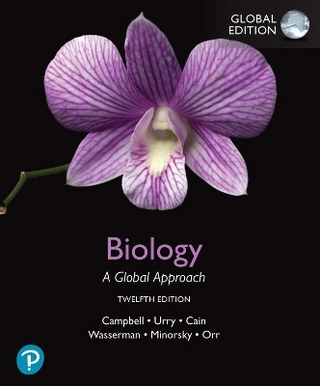
Instructor's Manual for Campbell Biology: Concepts & Connections, Global Edition
Pearson Education Limited (Hersteller)
978-1-292-40129-4 (ISBN)
- Titel ist leider vergriffen;
keine Neuauflage - Artikel merken
Martha R. Taylor has been teaching biologyfor more than 35 years. She earned her B.A. in biology from Gettysburg Collegeand her M.S. and Ph.D. in science education from Cornell University. AtCornell, Dr. Taylor has served as assistant director of the Office ofInstructional Support and has taught introductory biology for both majors andnonmajors. Most recently, she was a lecturer in the Learning Strategies Center,teaching supplemental biology courses. Her experience working with students inclassrooms, in laboratories, and with tutorials has increased her commitment tohelping students create their own knowledge of and appreciation for biology.She was the author of the Student Study Guide for ten editions of CampbellBiology. Eric J. Simon is a professor in theDepartment of Biology and Health Science at New England College in Henniker,New Hampshire. He teaches introductory biology to science majors and nonsciencemajors, as well as upper-level courses in tropical marine biology and careersin science. Dr. Simon received a B.A. in biology and computer science and anM.A. in biology from Wesleyan University, and a Ph.D. in biochemistry fromHarvard University. His research focuses on innovative ways to use technologyto improve teaching and learning in the science classroom. Dr. Simon also leadsnumerous international student field research trips and is a Scientific Advisorto the Elephant Conservation Center in Sayaboury, Laos. Dr. Simon is the leadauthor of the introductory nonmajors biology textbooks Campbell EssentialBiology, Seventh Edition, and Campbell Essential Biology with Physiology, SixthEdition, and the author of the introductory biology textbook Biology: The Core,Third Edition. Jean L. Dickey is Professor Emerita ofBiological Sciences at Clemson University (Clemson, South Carolina). Afterreceiving her B.S. in biology from Kent State University, she went on to earn aPh.D. in ecology and evolution from Purdue University. In 1984, Dr. Dickeyjoined the faculty at Clemson, where she devoted her career to teaching biologyto nonscience majors in a variety of courses. In addition to creatingcontent-based instructional materials, she developed many activities to engagelecture and laboratory students in discussion, critical thinking, and writing,and implemented an investigative laboratory curriculum in general biology. Dr.Dickey is author of Laboratory Investigations for Biology, Second Edition, andcoauthor of Campbell Essential Biology, Seventh Edition, and Campbell EssentialBiology with Physiology, Sixth Edition. Kelly Hogan is a faculty member in theDepartment of Biology at the University of North Carolina at Chapel Hill,teaching introductory biology and genetics. Dr. Hogan teaches hundreds ofstudents at a time, using active-learning methods that incorporate educationaltechnologies both inside and outside of the classroom. She received her B.S. inbiology at the College of New Jersey and her Ph.D. in pathology at theUniversity of North Carolina, Chapel Hill. Her research interests focus on howlarge classes can be more inclusive through evidence-based teaching methods andtechnology. As the Director of Instructional Innovation at UNC, she encouragesexperienced faculty to take advantage of new professional developmentopportunities and inspires the next generation of innovative faculty. Dr. Hoganis the author of Stem Cells and Cloning, Second Edition, and co-author onCampbell Essential Biology with Physiology, Sixth Edition. Neil A. Campbell (1946—2004) combined theinquiring nature of a research scientist with the soul of a caring teacher.Over his 30 years of teaching introductory biology to both science majors andnonscience majors, many thousands of students had the opportunity to learn fromhim and be stimulated by his enthusiasm for the study of life. While he isgreatly missed by his many friends in the biology community, his coauthorsremain inspired by his visionary dedication to education and are committed tosearching for ever better ways to engage students in the wonders of biology.
UNIT I: THE LIFE OF THE CELL
1. Biology: The Scientific Study of Life
2. The Chemical Basis of Life
3. The Molecules of Cells
4. A Tour of the Cell
5. The Working Cell
6. How Cells Harvest Chemical Energy
7. Photosynthesis: Using Light to Make Food
UNIT II. CELLULAR REPRODUCTION AND GENETICS
8. The Cellular Basis of Reproduction and Inheritance
9. Patterns of Inheritance
10. Molecular Biology of the Gene
11. How Genes Are Controlled
12. DNA Technology and Genomics
UNIT III. CONCEPTS OF EVOLUTION
13. How Populations Evolve
14. The Origin of Species
15. Tracing Evolutionary History
UNIT IV. THE EVOLUTION OF BIOLOGICAL DIVERSITY
16. Microbial Life: Prokaryotes and Protists
17. The Evolution of Plant and Fungal Diversity
18. The Evolution of Invertebrate Diversity
19. The Evolution of Vertebrate Diversity
UNIT V. ANIMALS: FORM AND FUNCTION
20. Unifying Concepts of Animal Structure and Function
21. Nutrition and Digestion
22. Gas Exchange
23. Circulation
24. The Immune System
25. Control of Body Temperature and Water Balance
26. Hormones and the Endocrine System
27. Reproduction and Embryonic Development
28. Nervous Systems
29. The Senses
30. How Animals Move
VI. PLANTS: FORM AND FUNCTION
31. Plant Structure, Growth, and Reproduction
32. Plant Nutrition and Transport
33. Control Systems in Plants
UNIT VII. ECOLOGY
34. The Biosphere: An Introduction to Earth’sDiverse Environments
35. Behavorial Adaptations to the Environment
36. Population Ecology
37. Communities and Ecosystems
38. Conservation Biology
Appendix 1. Metric Conversion Table
Appendix 2. The Periodic Table
Appendix 3. The Amino Acids of Proteins
Appendix 4. Chapter Review Answers
Appendix 5. Credits
| Erscheint lt. Verlag | 5.7.2021 |
|---|---|
| Verlagsort | Harlow |
| Sprache | englisch |
| Themenwelt | Naturwissenschaften ► Biologie |
| ISBN-10 | 1-292-40129-X / 129240129X |
| ISBN-13 | 978-1-292-40129-4 / 9781292401294 |
| Zustand | Neuware |
| Haben Sie eine Frage zum Produkt? |
aus dem Bereich

